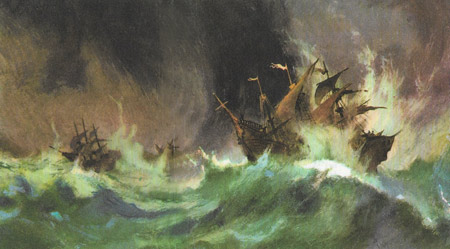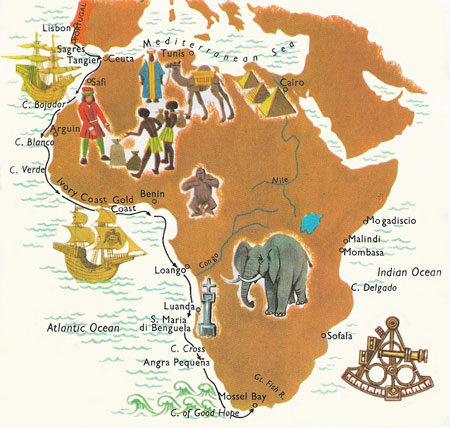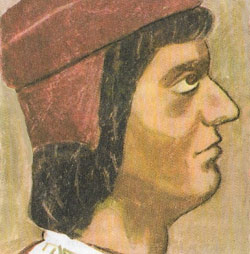Diaz, Bartholomew (c. 1450–1500)

Diaz' three ships were forced from land by a fierce storm off the southern tip of Africa.

The voyage of Bartholomew Diaz.
All through the 15th century the Portuguese kings and sea-captains had been inspired by two motives in their voyages of discovery: to find allies against the Moors of North Africa, and to find an ocean route to the rich spice islands of the East.
Italian merchants from Leghorn, Genoa, and especially Venice had an extremely profitable trade in luxuries such as perfumes, jewels, drugs, spices, carpets, and dyestuffs. These came from the East, and were brought by the Arabs either overland to the Black Sea or the Aegean Sea, or by ship up the Red Sea or Persian Gulf. At the ports of Antioch, Alexandria, and Trebizond, the Italian merchants met the Arabs and brought their goods, which they then sold all over Europe. The Italians were very careful not to allow other European nations to take part in this spice trade, and so were able to charge high prices and make huge profits. Like the Spaniards when they sent Columbus to look for the Indies, the Portuguese hoped to cut out the Italians and the Arab merchants by finding a sea route to the East.
Practically all the Iberian peninsula was conquered by the Moors from North Africa in the 8th century, and it was about 500 years before they were driven out of Portugal. One of the reasons why the Portuguese hated the Moors so bitterly was that the Portuguese were Christians and the Moors were Moslems. Since the Arabs were also of the Moslem faith, it was natural that the Portuguese should hate them too.
Having pushed the Moors out of Portugal, the Portuguese in turn began to invade North Africa, and in 1415 they captured Cuta, a port just across the Straits of Gibraltar. Part of their plan was to outflank the Moors by sending ships down the African coast. They also hoped to find the legendary and powerful Christian king known as Prester John. He was believed to rule a vat kingdom in Africa and the Portuguese hoped to enlist his aid against the Moors. Because of their geographical position it was natural for the Portuguese to seek their fortune on the high seas. Many of them were fishermen and sailors and were used to the Atlantic. The rulers were also powerful and were ready to use the country's position on the extreme south-west of Europe to expand into the Canary Islands, Madeira, and the coast of Africa.
Henry the Navigator
The man who did most to encourage the exploration of the coast of Africa was Prince Henry, the son of King John I of Portugal. He devoted himself so much to the problems of the new discoveries that e was called Henry the Navigator. He built an observatory on the coast of Portugal at Sagres where he called together people who were experts on maps, navigation and ship-building, to try and solve the problems of sailing into the unknown.
Gradually the ships that he sent out year after year went farther and farther down the long African coastline. After his death in 1460, King John II continued his work and in 1482 Diogo Cao sailed as far down as 22 south to Cape Cross. But the Portuguese still did not know if it was possible to sail round Africa and reach the East. This, Bartholomew Diaz was going to prove.
To the Cape of Storms
Bartholomew Diaz belonged to a family of sailors. A relative called Joao Diaz had sailed round Cape Bojador in 1434, and another called Diniz Diaz had discovered Cape Verde in 1445. The first record we have of Bartholomew himself was as captain of a ship trading in the gold and ivory of the West African coast.
 |
| Bartholomew Diaz, the Portuguese explorer
|
In 1486, King John II gave Diaz the money to fit out three ships, and soon afterwards he set sail on his famous voyage southwards. At first the winds were favorable, and Diaz passed quickly by the small forts and trading stations on the gold and Ivory Coasts. He then passed the stone crosses that Cao had set up at the mouth of the Congo, at Santa Maria di Benguela, and lastly at Cape Cross. At Angra Pequena, a little further south, Diaz erected a pillar on Christmas Day, 1487, and rested his ships and men.
Now they were in completely unknown seas, which were shown on old maps as being filled with monsters larger than ships, with boiling water, and terrible storms. At the end of the sea was the end of the world, or so many sailors thought. Indeed, as soon as they put out to sea again, a huge storm arose. For thirteen days it blew them steadily southwards, out of sight of land.
Until Diaz left Angra Pequena he had sailed along the coast in sight of land all the time. Now, however, there was no land to be seen in any direction, and obviously they had been driven far further south than anywhere shown on his maps. So after the storm had died down Diaz gave the order to turn east to try to find the coast again. For three days they sailed in this direction, but still they saw no land.
Diaz realized that they must have gone past the southern tip of Africa, and that it now lay to the north of them. So he ordered his ships to turn north, and on 3rd February 1488 he sighted land to the north, at Mossel Bay in Cape Colony. From there the ships sailed east to the Great Fish river, to make sure that the coastline went north-east to India. Then his tired men and officers forced him to turn back.
On the voyage home they passed the cape which they had not been in the great storm. Diaz named it Cape Tormentoso, or Cape of Storms. But when he finally returned to Portugal in December 1488 the king ordered it to be changed to Cabo da Boa Esperanca, or the Cape of Good Hope. The king realized that by rounding this southernmost point of Africa, the whole of the East was laid open to Portugal. But although Diaz discovered that it was possible to sail round Africa to the East, the honor of leading the first voyage to India was given to another Portuguese sailor – young Vasco da Gama. He finally reached the coast of India in 1498. The Portuguese then achieved on of their ambitions, the discovery of a sea route to the spice lands. But they failed in their other ambition to find allies to help them fight the Mors. They did, however, find a Christian king in Ethiopia whom they identified with Prestor John. Portugal later set up trading posts throughout the East and monopolized the spice trade.
Diaz' last voyage
In spite of the 1,260 miles of unknown coast that he had discovered, as well as the sea route to the East, poor Diaz was not rewarded with much. It was only as the captain of one of the thirteen ships of Alvares Cabral that he set sail in 1500. Driven off their course by a storm, they discovered Brazil, the easternmost part of South America.
From there they sailed on for India, and in yet another storm off the Cape of Good Hope four ships were lost. One of these was the ship that Diaz commanded, and he died, lost at sea off the cape that he himself called the Cape of Storms. Although it was he who first proved the existence of the sea route to the East, he never saw it himself.
